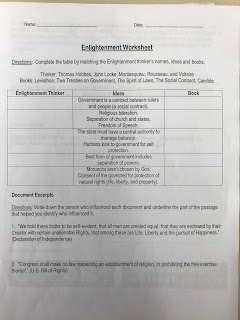Aim: What is Absolutism?
Bell Ringer: https://www.youtube.com/watch?v=3s1OdnGl7nI / Journal 71 – List topics
covered in class, and covered in this video.
Objectives:
1. Students will compare
the development of constitutional monarchy in England with that in France,
Spain, and Russia.
2. Students will use
political maps to describe the change in
Agenda:
1. Bell Ringer (20 min)
2. Review “Characteristics of an Absolute Monarch” (5 min)
3. All-Write-Round-Robin (15 min)
4. Quiz-Quiz-Trade (rest of class)
GRADED ON FRIDAY:
1. JOURNALS 61-70
2. TWO T-CHARTS ON THE ABSOLUTISM VIDEOS
3. SECTIONS 1-5 G.O. & ASSESSMENTS
4. ABSOLUTISM EXAM
5. BRING INITIALLED JOURNAL 71 TO USE AS NOTES.
BELOW ARE THE Quiz-Quiz-Trade (QQT) questions we used in class:
1.
Q - A system where a monarch wields supreme power and claims to
have to answer only to God / A – Absolutism
2. Q - A balance between
governmental powers and the rights of a government's subjects / A -
Constitutionalism
3. Q - The belief that a
King is God's chosen instrument on Earth and answerable to God alone / A -
Devine Right
4. Q - A system of
republican government, used to inaccurately characterize the Protectorate
under Cromwell (England) / A - Commonwealth
5. Q - A system central to
feudalism in which people worked on a lord's lands in exchange for protection /
A - Serfdom
6. Q - A King with limited powers. / A - Administrative Monarch
7. Q - The first King of the Bourbon dynasty
who converted to Catholicism to become King of France. / A - Henry IV
8. Q - The embodiment of French absolutism,
and longest-serving European monarch, who revoked the Edict of Nantes / A - King Louis XIV (The Sun King)
9. Q - The de facto capital of France during
the 18th century and home of an opulent palace. / A - Versailles
10. Q - Government policies to regulate a
nation's economic activities / A
- Mercantilism
11. Q - Last Tudor monarch
of England, successor to Elizabeth I /
A - James I
12. Q - Strong religiously conservative Protestants
in England who sought to eliminate Roman Catholic elements from the Anglican
Church. / A - Puritans
13. Q - A conflict between Parliamentary and
Royalist forces that ended with a victory for the Parliamentarians. / A - English Civil War
14. Q - Leader of the Parliamentary forces and
Lord Protector of England. / A -
Oliver Cromwell
15. Q - A law passed by Parliament
strengthening the rule that people unlawfully detained cannot be prosecuted by
a court of law. / A - Habeas
Corpus Act
16. Q - The bloodless deposition of James II
(when Queen Mary and her Husband William of Orange were put on the throne of
England by Parliament / A - Glorious Revolution 1688
17. Q - A document written by Parliament
following the Glorious Revolution enumerating certain guarantees for all
English citizens. / A - Bill of
Rights of 1689
18. Q - Foremost Spanish artist of Mannerism.
Painted "View of Toledo" and the "Burial of the Count of
Orgaz." / A - El Greco
19. Q - Muslim dynasty centered in Turkey that
had its peak between the 16th and 17th centuries. / A - Ottoman Empire
20. Q - The man under whom the Ottoman Empire
saw its zenith. Father of "Selim the Halfway Decent" / A -
Suleiman the Magnificent
21. Q - Eastern European nation located on the
present-day Czech Republic, the site of the beginning of the Thirty Years War. / A - Bohemia
22. Q - The son of Frederick William who
created a strong Prussian military and established strong absolutist rule in
Prussia / A - Frederick William I
"The Soldier's King"
23. Q - The Church formed as a result of the
Great Schism with the Catholic Church /
A - Eastern Orthodox Church
24. Q - The highest-ranking Russian nobles / A - Boyars
25. Q - A famous Tsar who sought to build the Russian
state and apply lessons from Western Europe to his own nation / A - Peter the Great
26. Q - Construction began on this city in
1702 and shortly thereafter it replaced Moscow as Russia's capital / A - St. Petersburg
27. Q – A famous Tsarina
who sought to expand Russia’s border / A – Catherine the Great






